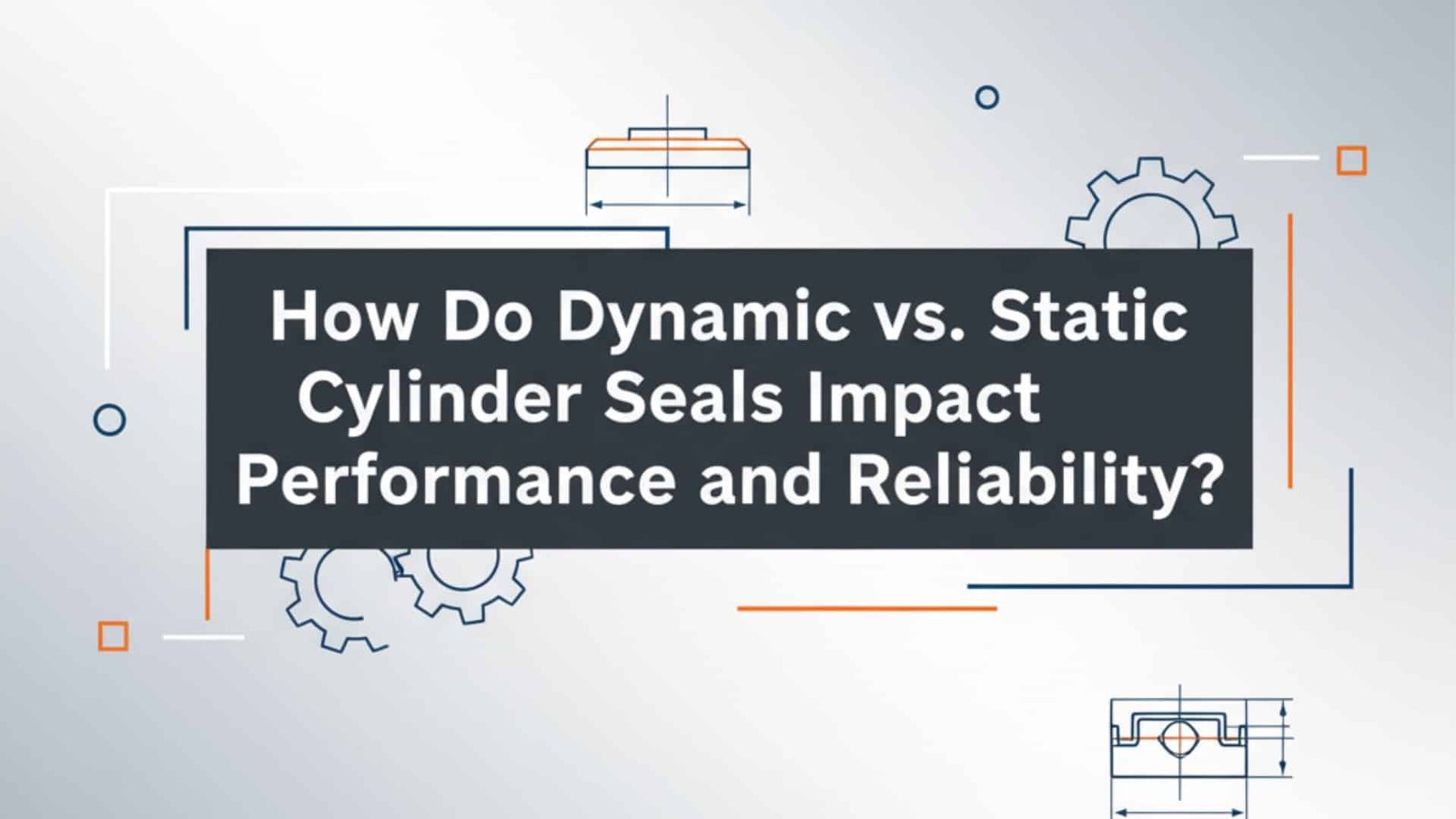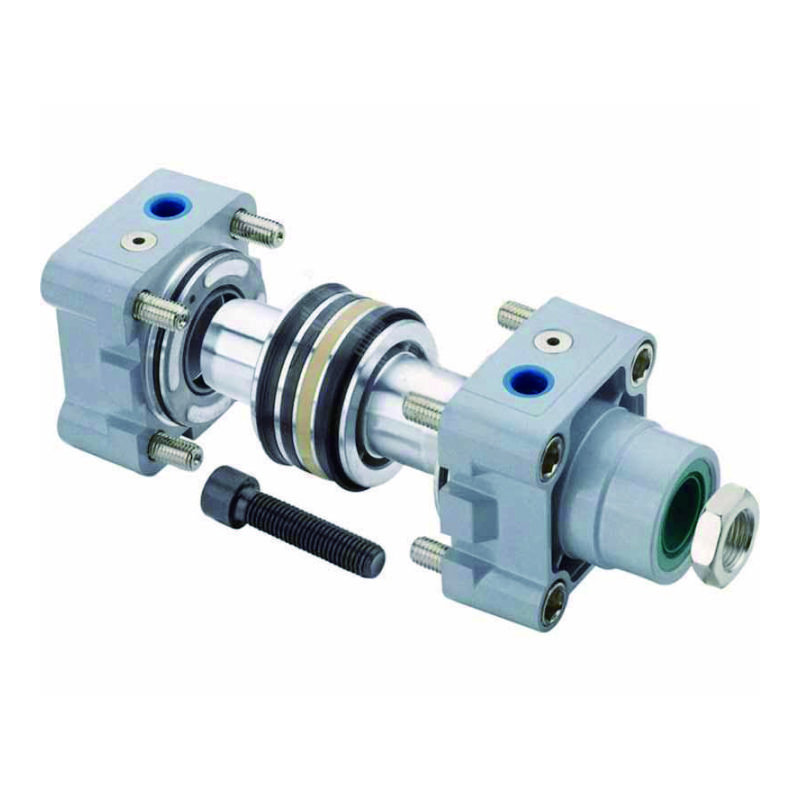
Die falsche Auswahl von Dichtungen ist die Ursache für 60% der Ausfälle von Pneumatikzylindern. Die Verwechslung von dynamischen und statischen Dichtungen führt zu vorzeitigem Verschleiß, Leckagen und kostspieligen Systemausfallzeiten von durchschnittlich $15.000 pro Vorfall in Produktionsumgebungen. Dynamische Dichtungen behandeln bewegliche Komponenten mit speziellen Werkstoffen und Konstruktionen für die Reibungskontrolle, während statische Dichtungen stationäre Druckbarrieren mit verschiedenen Verbindungen schaffen, die für Druckverformungsrest1 und langfristige Dichtungsleistung. Erst gestern habe ich Sarah, einer Wartungsingenieurin aus Michigan, geholfen, deren Produktionslinie täglich Dichtungsausfälle verzeichnete, weil sie statische O-Ringe in dynamischen Stangenanwendungen verwendete, was wöchentlich $8.000 an Produktionsausfällen verursachte. 🔧
Inhaltsübersicht
- Was sind die Hauptunterschiede zwischen dynamischen und statischen Zylinderdichtungen?
- Welche Dichtungstypen eignen sich am besten für bestimmte Zylinderanwendungen?
- Wie optimieren Bepto Dichtungslösungen die Leistung und Langlebigkeit?
Was sind die Hauptunterschiede zwischen dynamischen und statischen Zylinderdichtungen?
Das Verständnis der Dichtungsklassifizierungen und ihrer spezifischen Konstruktionsanforderungen ist für die ordnungsgemäße Leistung und Zuverlässigkeit von Pneumatiksystemen unerlässlich.
Dynamische Dichtungen gleichen Relativbewegungen zwischen Oberflächen mit speziellen Werkstoffen und Geometrien aus, die die Reibung minimieren und gleichzeitig die Dichtungsintegrität aufrechterhalten, während statische Dichtungen dauerhafte Barrieren zwischen stationären Komponenten schaffen, indem sie Materialien verwenden, die für Druckfestigkeit und langfristige Stabilität optimiert sind.

Dynamische Dichtungseigenschaften
Anforderungen an den Antrag:
- Anpassung an lineare oder rotierende Bewegungen
- Minimierung der Reibung zur Verringerung von Verschleiß und Energieverlust
- Aufrechterhaltung des dichtenden Kontakts bei unterschiedlichen Drücken
- Handhabung von Geschwindigkeitsänderungen und Richtungsumkehrungen
Gestaltungsmerkmale:
- Spezialisierte Lippengeometrien für Wischwirkung
- Reibungsarme Materialien und Oberflächenbehandlungen
- Kontrollierte Presspassungen für optimalen Kontakt
- Integrierte Sicherungsringe für Hochdruckanwendungen
Materialeigenschaften:
- Ausgezeichnet Abriebfestigkeit2
- Niedriger Reibungskoeffizient
- Formstabilität unter Last
- Chemische Verträglichkeit mit Systemflüssigkeiten
Statische Dichtungseigenschaften
Anforderungen an die Versiegelung:
- Schaffung einer dauerhaften Barriere zwischen stationären Flächen
- Widerstandsfähigkeit gegen Druckverformung über längere Zeiträume
- Aufrechterhaltung der Dichtkraft bei Temperaturschwankungen
- Ausgleich von Montagetoleranzen und Oberflächenunregelmäßigkeiten
Optimierung des Designs:
- Einfache Geometrien für zuverlässige Abdichtung
- Hohe Verdichtungsverhältnisse für positive Abdichtung
- Spannungsverteilung bei gleichmäßigem Anpressdruck
- Standardisierte Größen für einfachen Austausch
Leistungsvergleich
| Siegel Typ | Primäre Funktion | Reibungsgrad | Nutzungsdauer | Typische Anwendungen |
|---|---|---|---|---|
| Dynamisch | Bewegliche Dichtung | Gering bis mäßig | 1-5 Millionen Zyklen | Stangendichtungen, Kolbendichtungen |
| Statisch | Stationäre Schranke | Minimal | 10+ Jahre | Anschlussdichtungen, Flanschdichtungen |
Häufige Fehlermodi
Dynamisches Versagen von Dichtungen:
- Abrasiver Verschleiß durch Verschmutzung
- Strangpressen unter hohem Druck
- Thermische Degradation durch Reibungserwärmung
- Chemischer Angriff durch inkompatible Flüssigkeiten
Statisches Versagen der Dichtung:
- Druckverformungsrest durch Langzeitbelastung
- Thermal cycling damage
- Chemical degradation
- Installation damage during assembly
Sarah’s situation perfectly illustrates the importance of proper seal selection. Her maintenance team was replacing expensive rod seals with standard O-rings to save money, not realizing that static seals can’t handle the wiping action required for rod applications. The O-rings were failing within hours due to excessive friction and wear. We provided proper dynamic rod seals that have been running trouble-free for 6 months, eliminating her daily maintenance headaches! 💡
Welche Dichtungstypen eignen sich am besten für bestimmte Zylinderanwendungen?
Different cylinder locations and operating conditions require specific seal types and materials for optimal performance and reliability.
Rod seals require dynamic designs with wiping lips and low-friction materials, piston seals need bidirectional capability with pressure-activated sealing, while static seals in ports and flanges use compression-resistant materials optimized for long-term barrier performance.
Rod Seal Applications
Primary Functions:
- Prevent internal pressure leakage
- Exclude external contamination
- Minimize friction for smooth operation
- Provide long service life under cycling
Recommended Seal Types:
- Single-lip wipers for light-duty applications
- Double-lip seals for contaminated environments
- U-cup seals for high-pressure service
- Composite seals for extreme conditions
Piston Seal Applications
Performance Requirements:
- Bidirektionale Versiegelungsfähigkeit
- Pressure-activated sealing force
- Low breakaway friction
- Accommodation of side loading
Optimal Seal Configurations:
- O-ring with backup rings for standard service
- U-cup seals for high-pressure applications
- Composite seals for long-life requirements
- Custom profiles for special conditions
Anwendungsspezifische Auswahlhilfe
| Anmeldung | Siegel Standort | Recommended Type | Wahl des Materials | Erwartete Lebensdauer |
|---|---|---|---|---|
| Standard pneumatisch | Stab | Single-lip wiper | Polyurethan | 2M cycles |
| High-pressure hydraulic | Kolben | U-cup + backup | PTFE composite | 5M Zyklen |
| Lebensmittelverarbeitung | All dynamic | FDA compliant | EPDM/Silicone | 1M Zyklen |
| Hochtemperatur | All locations | Heat resistant | Viton/FFKM | 3M cycles |
Umweltbezogene Überlegungen
Auswirkungen der Temperatur:
- Low temperatures require flexible materials
- High temperatures demand thermal stability
- Thermal cycling needs expansion compatibility
- Heat generation from friction must be managed
Chemische Kompatibilität:
- Hydraulic fluids require specific elastomers
- Aggressive chemicals need PTFE or FFKM
- Food applications require FDA-approved materials
- Cleaning chemicals affect material selection
Kontaminationsfaktoren:
- Abrasive particles require hardened seals
- Moisture ingress needs effective wipers
- Chemical contamination affects material choice
- Filtration level influences seal design
Mark, a hydraulic system designer from Texas, was experiencing inconsistent cylinder performance due to mixed seal applications. His high-pressure system was using standard pneumatic seals that couldn’t handle 3000 PSI operating pressure. We analyzed his application and provided proper high-pressure composite seals with backup rings, eliminating leakage and extending service intervals from weekly to annual maintenance. His system now operates at peak efficiency with 99.9% reliability! 🎯
Wie optimieren Bepto Dichtungslösungen die Leistung und Langlebigkeit?
Our advanced seal technology and application expertise deliver superior performance, extended service life, and reduced total cost of ownership compared to standard sealing solutions.
Bepto seal solutions combine premium materials, precision manufacturing, comprehensive testing, and application-specific engineering that ensures optimal sealing performance while minimizing friction, wear, and maintenance requirements for maximum system reliability and efficiency.
Fortschrittliche Materialtechnologie
Premium Elastomers:
- High-performance polyurethanes for dynamic applications
- Specialized PTFE compounds for extreme conditions
- Custom material formulations for specific environments
- Enhanced additives for improved performance
Manufacturing Excellence:
- Precision molding for consistent dimensions
- Advanced surface treatments for reduced friction
- Quality control testing on every batch
- Traceability documentation for critical applications
Leistungsoptimierungsfunktionen
Dynamic Seal Enhancements:
- Optimized lip geometries for minimal friction
- Integrated wiping elements for contamination exclusion
- Pressure-balanced designs for consistent sealing
- Anti-extrusion features for high-pressure service
Static Seal Improvements:
- Enhanced compression set resistance
- Improved chemical compatibility
- Better thermal stability
- Standardized sizing for easy replacement
Comparative Performance Data
| Leistungsmetrik | Standard Seals | Bepto Seals | Verbesserung |
|---|---|---|---|
| Nutzungsdauer | 1 million cycles | 3-5 Millionen Zyklen | 300-400% |
| Reibungskoeffizient | 0.15-0.25 | 0.08-0.12 | 50% Ermäßigung |
| Leckagerate | 5-10 cc/min | <1 cc/min | 90% Verbesserung |
| Temperaturbereich | -20°F bis 200°F | -40°F to 300°F | Erweiterte Reichweite |
Application Engineering Services
Custom Seal Design:
- Application analysis and requirements definition
- Material selection for specific conditions
- Custom geometries for unique applications
- Performance validation and testing
Technische Unterstützung:
- Installation training and procedures
- Fehlersuche und Fehleranalyse
- Preventive maintenance recommendations
- Leistungsüberwachung und -optimierung
Qualitätssicherungsprogramm
Prüfprotokolle:
- Druckprüfung bis zum 4-fachen Arbeitsdruck
- Friction testing under actual conditions
- Accelerated aging for long-term performance
- Überprüfung der chemischen Verträglichkeit
Certification Standards:
- ISO 9001 quality management
- FDA compliance for food applications
- API specifications for oil and gas
- Custom certifications for specific industries
Value Proposition
Total Cost Benefits:
- 40% longer service life reduces replacement frequency
- 50% lower friction reduces energy consumption
- 90% fewer leakage incidents minimize downtime
- Comprehensive warranty coverage provides peace of mind
Our seal technology has delivered exceptional results across diverse applications: 95% reduction in seal-related failures, 60% extension in service intervals, and 45% reduction in total sealing costs. We provide complete sealing solutions, not just components, ensuring your pneumatic systems operate at peak performance with minimal maintenance requirements. 🛡️
Schlussfolgerung
Proper selection and application of dynamic and static cylinder seals is critical for pneumatic system performance, reliability, and cost-effectiveness.
FAQs About Dynamic vs. Static Cylinder Seals
Q: Can I use static O-rings as temporary replacements for dynamic rod seals?
No, static O-rings lack the specialized geometry and materials needed for dynamic applications. They will fail quickly due to excessive friction and wear, potentially causing more expensive damage to cylinder components and creating safety hazards.
Q: How do I determine if my application needs dynamic or static seals?
Dynamic seals are required wherever there is relative motion between sealed surfaces (rods, pistons). Static seals are used for stationary connections (ports, flanges, end caps). If components move relative to each other, dynamic seals are essential.
Q: What factors affect seal life in dynamic applications?
Key factors include operating pressure, cycle frequency, temperature range, contamination levels, fluid compatibility, and installation quality. Proper seal selection considering all these factors can extend life from thousands to millions of cycles.
Q: How often should cylinder seals be replaced in preventive maintenance?
Dynamic seals should be replaced based on cycle count (typically 1-5 million cycles) or performance degradation, while static seals can often last the cylinder’s lifetime unless exposed to extreme conditions. Monitor for leakage and performance changes rather than arbitrary time intervals.
Q: What makes Bepto seals superior to standard aftermarket options?
Bepto seals offer 300-400% longer service life, 50% lower friction, 90% better leakage performance, and extended temperature ranges compared to standard seals, backed by comprehensive application engineering and 3-year warranties versus typical 90-day coverage.



